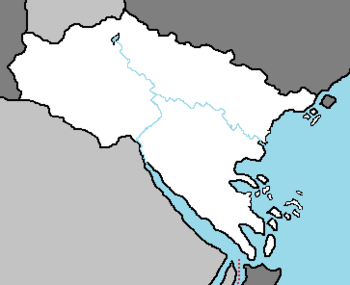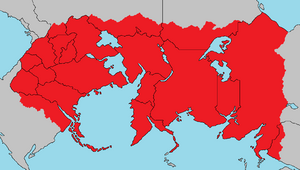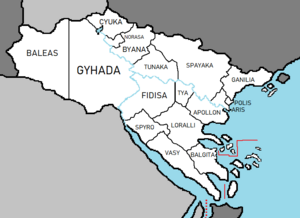Constantio
Republic of Constantio | |
|---|---|
|
Flag | |
 Constantio | |
| Capital | Constantinopolis |
| Largest city | Norasa |
| Demonym(s) | Constantioan |
| Government | Federal presidential constitutional republic |
| Tony Blanian | |
| Macie Shepard | |
| Toby Kennedy | |
| Establishment | |
• Empire | 1591 |
• Republic | 1 April 1846 |
• Last constitutional amendment | 8 August 2012 |
| Area | |
• | 423,967 km2 (163,695 sq mi) |
| Population | |
• 2020 estimate | 26,889,000 |
• Density | 63.42/km2 (164.3/sq mi) |
| GDP (PPP) | 2021 estimate |
• Total | 402.638 billion |
• Per capita | 16,872 |
| Gini | 41.2 medium |
| HDI | 0.888 very high |
| Currency | Norta |
| Date format | mm-dd-yyyy |
The Republic of Constantio, most commonly known as Constantio, is a nation in the Coalition of Crown Albatross located on the continent of Nortua, bordered by Birnir, Cechena, Syraranto, and a maritime border with Karabakhi. Constantio's location and prominent political influence in the Sotoa Sea region makes it a middle power, often competing with neighboring Syraranto for dominance in the region. Constantio's jagged coast line on the Sotoa Sea, the second longest on the body of water after Syraranto, is dotted with rocky islands and shallow reefs, making it a hotspot for bidiversity. Inland mountains and rolling hills dominate the mainland geographical buildup.
With a rich history extending back tens of thousands of years with early human civilization, Constantio rose to prominence with the foundation of the Constantio Empire in 1591 with the conquest of neighboring Cechena. As the empire grew, it expanded to become one of the largest in the history of the world, encompassing nearly a third of the continent of Nortua, with a range from northeastern Birnir to central Besmenia. The empire collapsed at the conclusion of the Chezian Wars of Independence (1806-23), and became a republic in the mid 1800s.
The nation is known for extensive civil rights and political freedoms, though recent years have seen rampant corruption scandals. Constantio was one of the nations involved in the extensive and bloody Chezian War (1992-95), which left tens of thousands dead in the effected areas of the country. It is considered a middle power, and is a member state of several international organizations such as the Coalition of Crown Albatross, the Coalition Trade Organization, and the Sotoan Basin Union. Its population of 26.9 million is largely urbanized, with the capital of Constantinopolis and the cities of Norasa and Balgita accounting for nearly a half of the country's total population. Its economy is well developed thanks to international cooperation and investment, with a GDP around 402.638 billion and a per capita GDP of 16,872.
History
Prehistory
Antiquity
Constantio Empire
Founding
Expansion
Decline
Modern Era
Republic
Geography

Located in Western Nortua, Constantio is bordered to the west by Birnir and Cechena, to the northeast by Syraranto, and to the south by the Sotoa Sea and the maritime border with the Karabakhi Archipelago. The highest point is Mount Torabe at 2,764 m (9,068.24 ft) in the westernmost corner of the country along the border with Cechena; the lowest point is the Sotoa Sea at 0 m (0.00 ft). Eighty percent of Constantio consists of mountains or hills, making the country one of the most mountainous in Nortua. Western Constantio contains a number of lakes and wetlands and is dominated by the Birnir Mountains and the Chezian Mountains.
Due to its highly indented coastline and numerous islands, the nation has an extensive coastline. It is dotted with rocky islands and shallow reefs, making it a hotspot for bidiversity. Patches of plain regions are primarily located in the northern regions. They constitute key economic regions as they are among the few arable places in the country. Rare marine species such as the pinniped seals and the loggerhead sea turtle live in the seas surrounding mainland Constantio, while its dense forests are home to the endangered brown bear, the Nortuan lynx, the roe deer and the wild goat.
The climate of Constantio is primarily dry summer climate, featuring mild, wet winters and hot, dry summers. This climate occurs at all coastal locations, including Balgita. The Chezian mountain range strongly affects the climate of the country, as areas to the west of the range are considerably wetter on average (due to greater exposure to south-westerly systems bringing in moisture) than the areas lying to the east of the range (due to a rain shadow effect).
The mountainous areas of Northwestern Constantio feature an Alpine climate with heavy snowfalls. The inland parts of northern Constantio feature a temperate climate with cold, damp winters and hot, dry summers with frequent thunderstorms. Snowfalls occur every year in the mountains and northern areas, and brief snowfalls are not unknown even in low-lying southern areas near the coast.
Politics
The Republic of Constantio is a federal republic of 16 provinces and a federal district. It is a federal republic and a representative democracy. The nation's politics operate under a framework laid out in the constitution wherein the President of Constantio functions as the head of state and the Vice President and Assembly of Constantio operate jointly as the head of government. The government is based on the separation and balancing of powers among the legislative (Assembly of Constantio), judiciary (Supreme Court of Constantio) and executive (President). The executive power is exercised by the president. The president is the commander-in-chief of the military and the representative of the unity of the Constantioan people. Presidential elections and Assembly elections occur at the same time every three years, with the most recent election having been held on August 21st, 2021.
The capital is located in Constantinopolis, which serves as a federal district.
Political Parties
Upon the foundation of the Republic on April 1st, 1846, the dominant party in Constantio was the liberal-conservative New Democracy (ND) and the social-democratic Constantio Socialist Movement (CSM). In the 21st century, other parties have gained prominence such as the Progressive Party, the Green Party
Administrative Divisions
Constantio is divided into 16 provinces and one federal district which constitutes the capital of Constantinopolis.
| Province | Capital | Governor |
|---|---|---|
| Baleas | Iliougara | Ashton Stanton |
| Gyhada | Darina | Leo Lowe |
| Norasa | Norasa | Holden Anthony |
| Cyuka | Alifplio | Eddie Christensen |
| Byana | Trapapolis | Jaeden Gill |
| Tunaka | Tunaka | Daniel Harris |
| Spayaka | Cesegliari | Jeffrey Shelton |
| Ganilia | Pocia | Sean Mcdonald |
| Aris | Missokastro | Chandler Thompson |
| Appolon | Tarralusia | Patrick Murray |
| Loralli | Gremno | Keaton Aguirre |
| Balgita | Balgita | Oliver Harrison |
| Vasy | Caltaci | Finlay Moss |
| Spyro | Kozakas | Kayden Adams |
| Tya | Folina | Caden Simon |
| Fidisa | Zamanca | Giovanni Petersen |
Military
Foreign Relations
Demographics
Language
Religion
Culture
Cities
Cities
See also: Cities in Constantio
|
Metropolitan areas in Constantio | |||||
| No. | CMA City |
Population | |||
| 1 | Norasa | 4,349,000 | |||
| 2 | Constantinopolis | 1,233,000 | |||
| 3 | Balgita | 1,023,000 | |||






